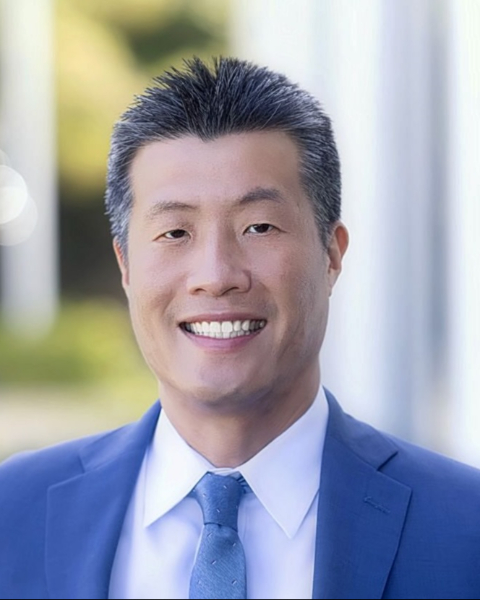SS 32 - Lung 4: Clinical Trials of SBRT and Hypofractionation for NSCLC
287 - Accelerated Hypofractionated Chemoradiation Followed by Stereotactic Ablative Radiotherapy Boost for Locally Advanced, Unresectable Non-Small Cell Lung Cancer: Final Results from a Nonrandomized Contr
Tuesday, October 1, 2024
1:25 PM - 1:35 PM ET
Location: Room 147

Percy Lee, MD, FASTRO
City of Hope National Medical Center
Rancho Santa Margarita, CA, United States
Presenter(s)
P. Lee1, J. Goldman2, E. Garon2, E. Luterstein3, B. K. Neilsen4, J. M. Lee5, C. Felix4, M. Cao4, S. E. Tenn4, D. Low4, P. A. Kupelian6, M. L. Steinberg4, and T. C. Wu4; 1Department of Radiation Oncology, Lennar Foundation Comprehensive Cancer Center, City of Hope National Medical Center, Irvine, CA, 2Department of Medicine, Division of Hematology and Oncology, University of California, Los Angeles, Los Angeles, CA, 3University of California San Diego Department of Radiation Medicine and Applied Sciences, La Jolla, CA, 4Department of Radiation Oncology, University of California, Los Angeles, Los Angeles, CA, 5Department of Surgery, Division of Thoracic Surgery, University of California, Los Angeles, Los Angeles, CA, 6Varian Medical Systems, Palo Alto, CA
Purpose/Objective(s): Intrathoracic progression remains the predominant pattern of failure in patients treated with concurrent chemoradiation followed by a consolidation immune checkpoint inhibitor for locally advanced, unresectable non-small cell lung cancer (NSCLC). The objective of this study was to determine the maximum tolerated dose (MTD) and use of hypofractionated concurrent chemoradiation with an adaptive stereotactic ablative radiotherapy (SABR) boost. Materials/
Methods: This was an early-phase, single institution, radiation dose-escalation nonrandomized controlled trial with concurrent chemotherapy among patients with clinical stage II or III NSCLC who were inoperable or refused surgery. Patients were enrolled and treated from May 2011 to May 2018 with a median patient follow-up of 18.2 months. Patients advanced to a higher SABR boost dose if dose-limiting toxicity (any grade 3 or higher pulmonary, GI, or cardiac toxicities, or any non-hematologic grade 4 or higher toxicities) occurred in fewer than 33% of the boost cohort within 90 days of follow-up. The current analyses were conducted from January to September 2023. All patients first received 4 Gy x 10 fractions followed by an adaptive SABR boost to residual metabolically active disease, consisting of an additional 25 Gy (low, 5 Gy x 5 fractions), 30 Gy (intermediate, 6 Gy x 5 fractions), or 35 Gy (high, 7 Gy x 5 fractions) with concurrent weekly carboplatin/paclitaxel.
Results: Data from 28 patients (median age, 70 [51-88] years; 16 [57%] male; 24 [86%] with stage III disease) enrolled across the low - (n=10), intermediate- (n=9), and high- (n=9) dose cohorts were evaluated. The protocol specified MTD was not exceeded. The incidence of non-hematologic acute and late (>90 days) grade 3 or higher toxicities were 11% and 7%, respectively. No grade 3 toxicities were observed in the intermediate-dose boost cohort. Two deaths occurred in the high-dose cohort. Two-year local control was 74.1%, 85.7%, and 100.0% for the low-, intermediate-, and high-dose cohorts, respectively. Two-year overall survival was 30.0%, 76.2%, 85.7%, and 100.0% for the low-, intermediate-, and high-dose cohorts, respectively.
Conclusion: This early-phase dose-escalation nonrandomized controlled trial showed that concurrent chemoradiation with an adaptive SABR boost to 70 Gy in 15 fractions with concurrent chemotherapy is safe and effective regimen for patients with locally advanced, unresectable NSCLC. This regimen may warrant further exploration and integration with immunotherapy in patients with unresectable stage II-III NSCLC in the CRT-IO era.
Purpose/Objective(s): Intrathoracic progression remains the predominant pattern of failure in patients treated with concurrent chemoradiation followed by a consolidation immune checkpoint inhibitor for locally advanced, unresectable non-small cell lung cancer (NSCLC). The objective of this study was to determine the maximum tolerated dose (MTD) and use of hypofractionated concurrent chemoradiation with an adaptive stereotactic ablative radiotherapy (SABR) boost. Materials/
Methods: This was an early-phase, single institution, radiation dose-escalation nonrandomized controlled trial with concurrent chemotherapy among patients with clinical stage II or III NSCLC who were inoperable or refused surgery. Patients were enrolled and treated from May 2011 to May 2018 with a median patient follow-up of 18.2 months. Patients advanced to a higher SABR boost dose if dose-limiting toxicity (any grade 3 or higher pulmonary, GI, or cardiac toxicities, or any non-hematologic grade 4 or higher toxicities) occurred in fewer than 33% of the boost cohort within 90 days of follow-up. The current analyses were conducted from January to September 2023. All patients first received 4 Gy x 10 fractions followed by an adaptive SABR boost to residual metabolically active disease, consisting of an additional 25 Gy (low, 5 Gy x 5 fractions), 30 Gy (intermediate, 6 Gy x 5 fractions), or 35 Gy (high, 7 Gy x 5 fractions) with concurrent weekly carboplatin/paclitaxel.
Results: Data from 28 patients (median age, 70 [51-88] years; 16 [57%] male; 24 [86%] with stage III disease) enrolled across the low - (n=10), intermediate- (n=9), and high- (n=9) dose cohorts were evaluated. The protocol specified MTD was not exceeded. The incidence of non-hematologic acute and late (>90 days) grade 3 or higher toxicities were 11% and 7%, respectively. No grade 3 toxicities were observed in the intermediate-dose boost cohort. Two deaths occurred in the high-dose cohort. Two-year local control was 74.1%, 85.7%, and 100.0% for the low-, intermediate-, and high-dose cohorts, respectively. Two-year overall survival was 30.0%, 76.2%, 85.7%, and 100.0% for the low-, intermediate-, and high-dose cohorts, respectively.
Conclusion: This early-phase dose-escalation nonrandomized controlled trial showed that concurrent chemoradiation with an adaptive SABR boost to 70 Gy in 15 fractions with concurrent chemotherapy is safe and effective regimen for patients with locally advanced, unresectable NSCLC. This regimen may warrant further exploration and integration with immunotherapy in patients with unresectable stage II-III NSCLC in the CRT-IO era.
